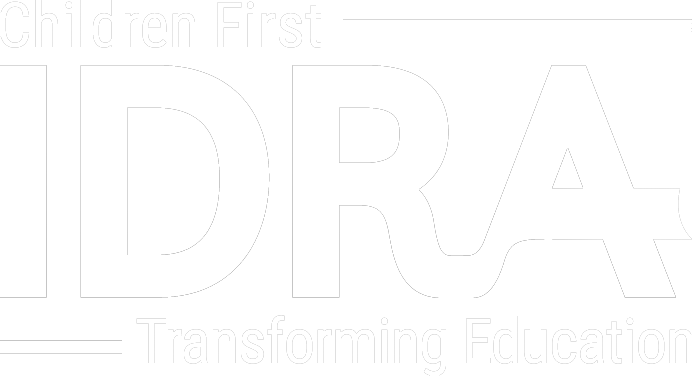• by William S. White • IDRA Newsletter • November – December 1996 •
The Berlin Wall. What does it mean to you? Stop a moment, don’t read any further, close your eyes, and picture the city of Berlin with the wall running through it. What images do you see? What does it symbolize to you?
Now, picture South Africa and another Berlin Wall, a racial wall, if you will. What pictures come into your mind? Let’s move to another part of the world – Bosnia. What kind of Berlin Wall divides the people of Bosnia? How impenetrable does that wall seem to be? And what of America? Think about our urban centers – Detroit, Chicago, Los Angeles, New York. Do they have Berlin Walls? What do they look like? What must they feel like, depending upon which side of the wall you face? Finally, think about your own community. Is there a Berlin Wall in your own backyard? How did it get there? How does it divide your community? More importantly, how do you make it go away?
In going through this thought process, one can’t help but realize that mental walls are just as formidable as walls of bricks and mortar. Motivated often by fear, we build mental barriers-Berlin Walls of the mind – to protect ourselves. The problem is that when we build walls – whether mental or physical – we destroy our relationships with one another. And that connectedness or belonging is fundamental to community and civil society.
Over the past several years, I and others at the Mott Foundation have discussed the concept of Berlin Walls of the Mind. For each one of us, the concept evokes different images and visions. Yet for each of us, it is a powerful and instructive symbol for the divisiveness of our times.
I have found these discussions intriguing, particularly in light of the fact that the nation, at the brink of a new millennium, is arguing with itself over values, over its future direction, over its role in the world, over its responsibilities to its citizens and even over its very identity.
For me, defining America as a community starts with a civil society. A civil society is a place – first and foremost – where there is a sense of community or connectedness. A civil society embraces tolerance and respect for not just the diversity of people and cultures, but also the diversity of ideas. A civil society is a place where freedom is celebrated, and justice and equity are paramount. A civil society is a place where the rights of individuals are respected, and individuals respect the rights and needs of the greater community. A civil society is a place where civic participation undergirds everything.
I don’t know about you, but I have serious doubts that the United States of the mid1990s can lay claim to being a truly civil society. Perhaps we never could. Some argue that for too many Americans, freedom still is only a word. The fact remains that without civil society, democracy is tenuous at best. But rather than building a civil society, Americans seem bent upon building walls.
Over the past many months, I have talked with people from all walks of life who also are troubled by a sense that we just aren’t as civil a society as we should be. They talk about things as complex as kids in our cities gunning each other don in a daily bloodbath and things as simple as our rage when someone cuts us off on the highway. They perceive an increasing desire on the part of Americans to turn off, tune out and reject the civic life around them. They question what is in store for our children-and even our democracy-if we become a nation with little or no connectedness.
One can easily see where this concern comes from. We are a nation grappling with complex issues, ranging from welfare reform to reinventing schools to social and economic instability. Over the past couple of years, we have endured far too many defining moments that have contributed to our sense of futility and isolation. Together we have witnessed: the inexplicable growth in church burnings across the country, particularly black churches; the Waco, Oklahoma City bombings and most recently Freemen crises; the O.J. Simpson trial and the affirmative action debate; California’s bitter vote on immigration; and a welfare reform debate that, for all its Good Intentions, more often tended to scapegoat the poor for their poverty and to take out our national frustrations on the most vulnerable members of society.
Other disturbing trends have further numbed our sensibilities: the explosion of violence among young people; the unchecked rise in hate radio and trash talk/tabloid television; an unrelenting torrent of sensationalized media coverage; and the growth of sportsrelated violence.
The cumulative effect of these incivilities, great and small, has taken its toll. Americans show an increasing sense of intolerance that all too often translates into selfimposed isolationism and extremism. To my mind, this sense of isolation – wallbuilding, so to say – has become one of the dominant characteristics of contemporary American life.
Having spent years guiding a foundation whose activities speak to the fundamental belief that connectedness – community, if you will – is essential to democracy, I find it deeply disturbing to realize how fragile the idea of community has become. I can think of no quicker way of letting democracy slip away from us than by walling ourselves off from each other.
This belief has been soundly reinforced over the past several years by our work in a number of former Iron Curtain countries, which until recently knew all about walls and little about democracy. Moreover, we have spent considerable time in South Africa, another new democracy, which until very recently had its own legally sanctioned walls of exclusion, inequality and oppression.
What we have seen is eyeopening: countries virtually destroyed because of hatred and discrimination, because of a oneparty system based on intolerance for differing people and ideas. But we also saw hope and determination. We heard how ordinary people with a vision of a civil society were able to topple oppression; how they had the courage to tear down the walls that have separated them as people, shake off the structures of the past and seek a better tomorrow – a tomorrow built upon inclusion, participation, diversity. Without question, this is an incredible challenge, given their history and those individuals who would derail any efforts toward an inclusive society.
Seeing these struggles reminded me of one of the most famous walls of all time, which sliced into the very heart of community. In its heyday, the Berlin Wall was a gray monster, complete with barbed wire and armed guards, a horribly apt symbol of the Cold War. I have wondered many times how the people of Berlin survived this nearfatal blow.
But the fact remains that when citizens on both sides of the Berlin Wall knocked it down, they took part in the greatest symbolic act of our era. They proved a simple truth: The democratic impulse is fundamentally at odds with walls that separate the prosperous from the impoverished, the free from the oppressed.
I think we in the United States have lost sight of that impulse, and I fear that the democratic promise here at home is slipping away from us with every wall we build that destroys our connectedness.
Charles Stewart Mott had a keen understanding of the fundamental contradiction between walls that keep us apart and the commitment to the common good that defines a democracy. That is why he saw such value in supporting programs that build social capital – programs such as community schools, which stressed community improvement through active adult and child participation, training and lifelong learning.
From my perspective, such partnerships and civic participation undergird a civil society. They are the tools that create and maintain our sense of connectedness, our sense of community. And it is at the roots of community that we find our most fundamental values such as caring, decency, trust, tolerance, honesty, forgiveness and faith. These common values – not real or imagined walls “protecting” us from one another – are the key to the future.
But there is another, critical element that has gotten away from us in America. Here again, we can learn from the world’s fledgling democracies. Dr. Zhelyu Zhelev, the president of Bulgaria, put it succinctly when he told me that a society cannot be democratic or civil unless it has a fundamental tolerance and respect for differing and often competing ideas and opinions.
It should concern us that more and more people feel so disenfranchised that they accept no responsibility to join the debate. But we can’t achieve consensus unless we come together and until we tear down the walls that separate us. Unless a society is willing and committed to discussing competing ideas, it will never be respectful and tolerant of different cultures and people or different ethnic and racial backgrounds. Tolerance of people and ideas go hand in hand.
Because I have thought a great deal about democratic values, my own vision is crystal clear. I firmly believe that with the right kind of nurturing, people can reclaim, reestablish and reinvigorate our democracy. We should not be a nation of strangers, but a nation engaged. We need to realize that it is only be actively participating that we can change what we believe to be wrong. And we can start right in our own backyard.
First and foremost, there is no room in a democracy for spectators. As an election monitor this year for the Palestinian elections, I saw how proud these citizens were to cast their ballots. For them, it was an important step not only in civic duty, but also in nation building. Likewise, our work in South Africa, particularly over the past two years, has given us a genuine appreciation for what democracy means to those who have been denied it. There we saw “new” citizens stand in line not just for hours, but for days, to exercise their right to vote. Even in Bosnia, where again, I was privileged to serve as an election monitor, I saw the determination of people to have a voice in the future of their civilwartorn nation.
Here at home, where the right to vote has been a cornerstone for our society, many of us can’t be bothered. We must make the exercise of democratic citizenship a priority in our lives.
Second, our churches, synagogues and mosques, our social and professional clubs, and our recreational leagues are a few examples of the kinds of civic organizations in which Americans have historically participated. They constitute the informal infrastructure that makes our communities work. These are important places where people from all parts of a community come together, defining community priorities and finding ways to demonstrate leadership. We need to encourage citizen participation in these organizations and others like them.
Third, we need to create “safe” places or opportunities where people from all parts of a community can come together and talk about our differences, our concerns, our hopes and dreams. There are a variety of ways of doing so. One place that comes to mind from the Mott Foundation’s many years of funding education is the school. Our experience tells us that our schools are probably the single most important institution to the future of every American community. I believe we have the best chance of coming together by realizing the power and potential of schoolcommunity partnerships.
In the final analysis, all of these things are about bringing people together – about connectedness. But we must renew both our respect for each other’s differences and our sense of common purpose. A change so fundamental must take root where all changes in attitude have their beginnings – in each individual conscience. If we are really committed to building a better society for future generations, the time to change is now. I think the interviews that follow in these pages offer a place, perhaps, to begin.
Let me end my comments at that most infamous wall of our time.
Thanks to the events of recent years, the Berlin Wall now symbolizes more than division. By crumbling, it almost miraculously has become a symbol of unity, persistence and courage. I am in awe of the people who remained faithful to the idea that one day the wall would be torn down – that their children would dance with joy as it disintegrated. That day came at last.
Such a day can come to America – a day when we stand reunited, proud of our separate identities, respectful of our differences, but reinvigorated by the knowledge that we can and must share a common home.
Reprinted with permission from America’s Tattered Tapestry: Can We Reclaim Our Civility Through Connectedness? 1995 Annual Report of the Charles Stewart Mott Foundation.
Comments and questions may be sent via e-mail at feedback@idra.org.
[©1996, IDRA. This article originally appeared in the November – December 1996 IDRA Newsletter by the Intercultural Development Research Association. Permission to reproduce this article is granted provided the article is reprinted in its entirety and proper credit is given to IDRA and the author.]



